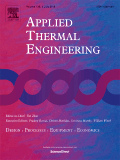 Authors: C. SALPINGIDOU¹, Z. VLAHOSTERGIOS¹, D. MISIRLIS³, S. DONNERHACK², M. FLOUROS², A. GOULAS¹, K. YAKINTHOS¹
Authors: C. SALPINGIDOU¹, Z. VLAHOSTERGIOS¹, D. MISIRLIS³, S. DONNERHACK², M. FLOUROS², A. GOULAS¹, K. YAKINTHOS¹
Affiliations: ¹Laboratory of Fluid Mechanics & Turbomachinery, Department of Mechanical Engineering, Aristotle University of Thessaloniki, Thessaloniki 54124, Greece, ²MTU Aero Engines AG, Dachauer Strasse 665, Munich, Germany, ³Technological Educational Institute (TEI) of Central Macedonia, Serres, Greece
Reference: Salpingidou, C., Vlahostergios, Z., Misirlis, D., Donnerhack, S., Flouros, M., Goulas, A., & Yakinthos, K. (2017). Thermodynamic analysis of recuperative gas turbines and aero engines. Applied Thermal Engineering, 124, 250–260.
Abstract: “In the current work, the thermodynamic cycle of a conventional recuperative aero engine, in which a heat exchanger is placed after the power turbine, is compared with the thermodynamic cycles of two nonconventional recuperative aero engine configurations. For each configuration, different heat exchanger designs were used, all having the same core arrangement as the heat exchanger in the conventional recuperation aero engine which was designed by MTU aero engines AG and has been initially used in the first concept of the Intercooled Recuperative Aero engine of MTU…..”
DOI: 10.1016/j.applthermaleng.2017.05.169
Comments: the authors are making an extensive use of COFE in order to model various recuperative gas turbine cycles. While the flexibility of COFE is noticed, there is no actual use of CAPE-OPEN technology to interface COFE with another piece of software. The authors compare COFE to other pieces of software like gTurb and CyclePad but no attempt is made to make these a CAPE-OPEN Unit Operation or to make use of COCO thermodynamic server (TEA) within gTurb or CyclePad.
